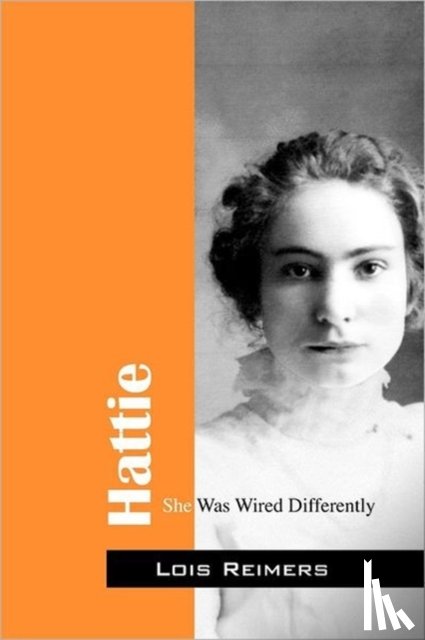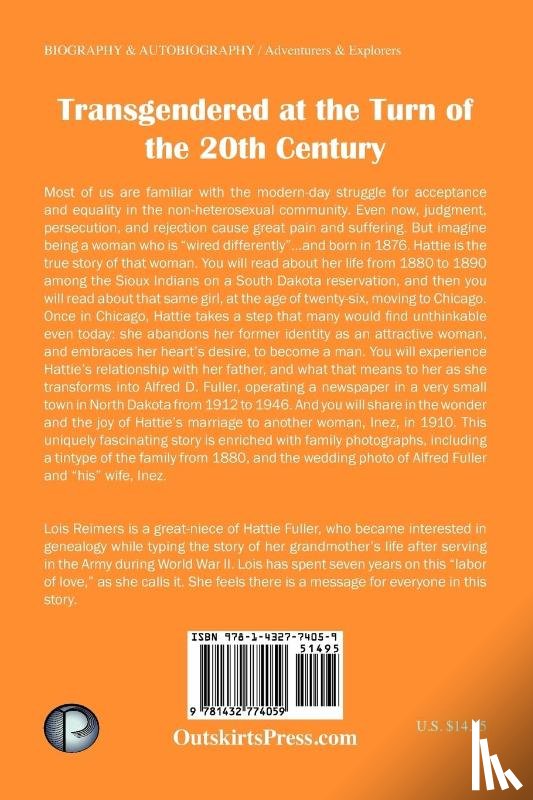Omschrijving
HATTIE
SHE WAS WIRED DIFFERENTLY
This is a true story of a girl named Hattie, born in 1876 she grew up with four sisters and one brother between 1881 and 1890 near Chamberlain, South Dakota.
Her family lived on an Indian reservation while, her father, Melroy Fuller, built a Catholic church for the Indians. The Fuller family then moved onto an Indian agency and lived among the Sioux Indians, until the last Indian War on the Rose Bud reservation in the Black Hills of South Dakota, across the Missouri River from their agency in 1890. The Fuller Family then moved to Salem, South Dakota.
Hattie, at age 26, moved to Chicago, at the turn of the century, changing her identity, from an attractive woman, into her hearts desire,
I inherited all my Grandmother, Nellie's pictures and papers and began putting together Hattie's life story, a labor of love for 7 years. The family pictures are fascinating beginning with a tintype of the family in 1881 when Hattie was only 5 and another picture of
"I know my Great Aunt Hattie Fuller would be appalled that I have written her life story, but I think it is time for it to be told not to "out" her for some sick unkind reason, but because I felt if someone in the years 1876 to 1946 her lifetime, wanted so badly to live as a different gender person then it could not have been a preference."
I ran across Hattie's story while tracing my genealogy. My Grandmother, Nellie Fuller Carey had me type her family early history. She also said her father, Melroy Fuller, could be traced back to the Mayflower Fullers, Samuel and Edward.
I decided I would try to make this connection to the Pilgrims after my Grandmother passed. I then ran into this fascinating story of my Grandmothers younger sister, Hattie, I learned had lived almost her entire adult life as a man. She dressed as a man, smoked cigars, and married a woman. They had lived together in the small town of Rhame, North Dakota. Hattie had bought the weekly newspaper operating it from 1916 to 1946.
She was on the school board and belonged to several men's clubs in town where she was known as Cappie or Alfred D. Fuller.
I decided to tell the story of this remarkable woman and her family, not to "out" her, but to let people see, how very deep the choices of who we are must be etched on our psyche.
When you read "HATTIE" I think you will wonder how she found the courage to lead the kind of life she led. Thank God, she had the family especially her Father,who supported her, all her life. He shielded her secret by accept-ing her exactly the way she was.
Lastly you may ask why am I "Outing Her Now"
I thought more people need to take a look at the struggle a person who is perhaps wired differently than the rest of us still has in this century!
I asked can we begin to look with love and tolerance at people who are different. I asked myself, isn't that what all religions say to do?
Then I asked why should a person need to hide who "they" are?
I then asked myself what would God have me do.
I remember reading "The Well Of Loneliness" by Radcliff Hall written in 1920. When originally published it was banned outright, more than eight hundred copies of the book were confiscated and a summons was served on the American publisher on moral charges because the characters in the novel did not apologize for their , but were portrayed with sympathy. Finally released in 1928 it became one of the year's bestsellers. George Bernard Shaw said "It speaks of things people ought to know about".
Lois Reimers




